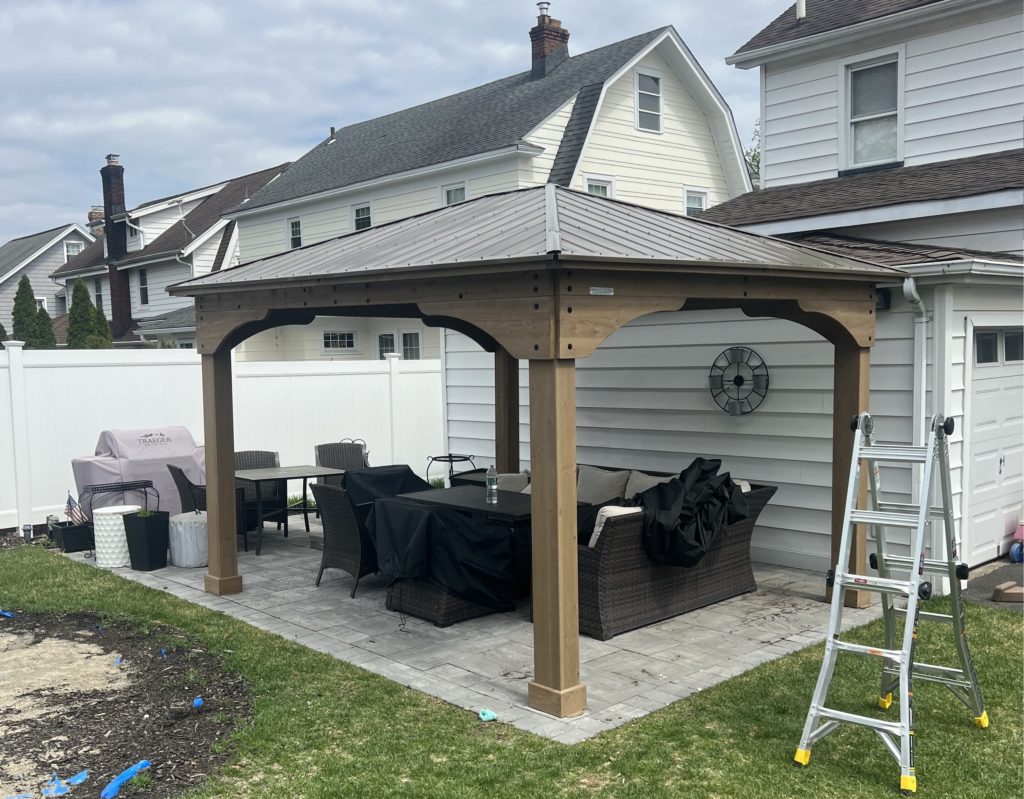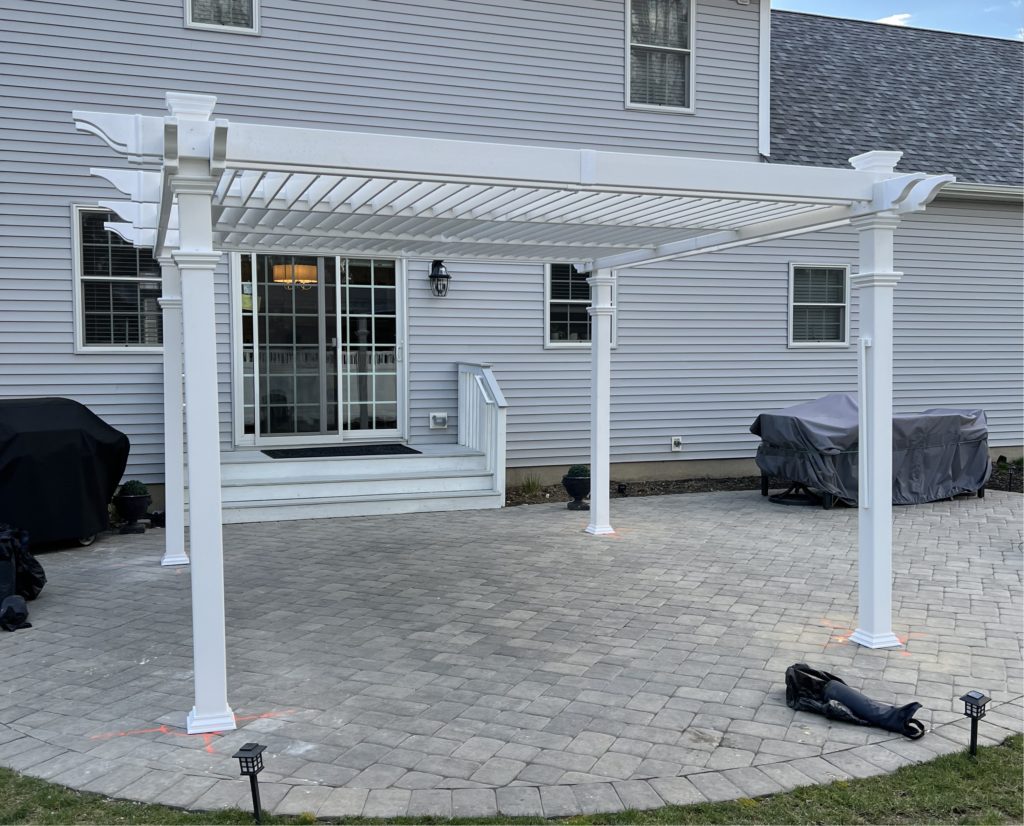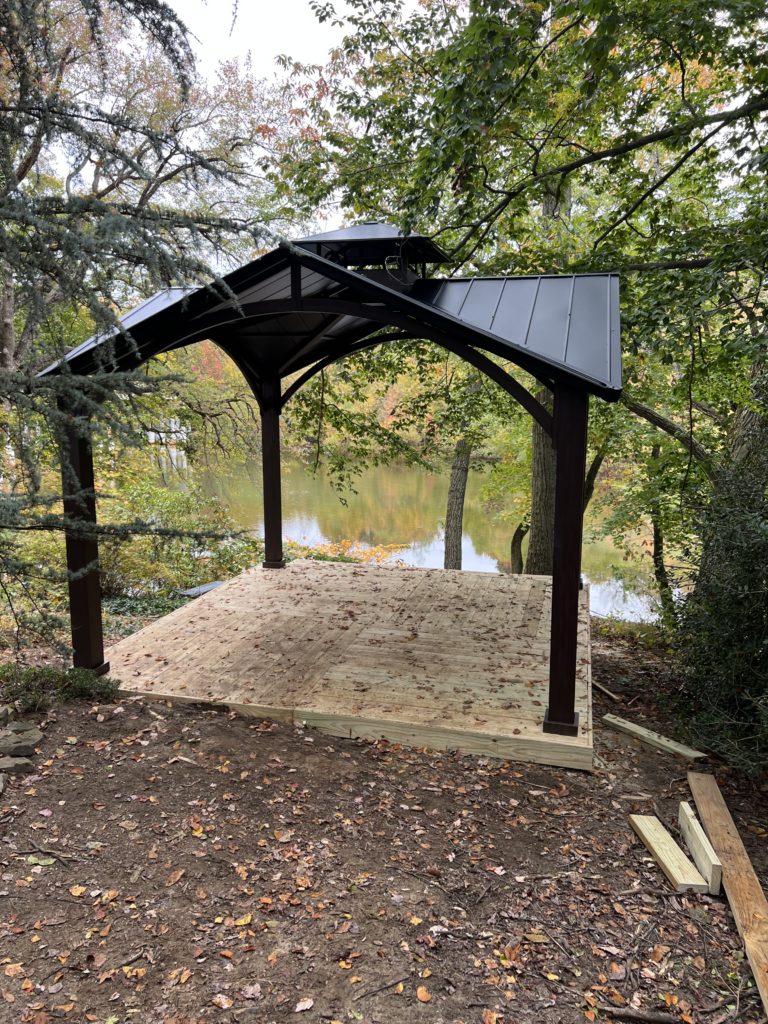Gazebos and pergolas are outdoor structures that add charm and functionality to any backyard or garden. These structures provide a shady retreat for relaxation, dining, or socializing, creating a perfect space for outdoor gatherings. If you are considering adding a gazebo or pergola to your outdoor space, this guide will walk you through the assembly and installation process of a 3×7 model.
OUR CONTACT
Email Support:
info@gazebo-installation.com
Ask your question:
info@gazebo-installation.com
Some of Our Portfolio Gazebo and Pergola Assembly Projects



Assembling and installing a gazebo or pergola may seem like a daunting task, but with the right tools and instructions, it can be a straightforward and rewarding project. This guide will provide you with step-by-step instructions on how to assemble and install a 3×7 gazebo or pergola, including tips and tricks to make the process smoother and more efficient.
Preparation and Tools Needed
Before starting the assembly and installation of your 3×7 gazebo or pergola, it is important to gather all the necessary tools and prepare the area where the structure will be placed. Here are some tips on what you will need:
- Tools:
- Drill with bits
- Screwdriver
- Hammer
- Level
- Measuring tape
- Work gloves
- Safety goggles
- Materials:
- Gazebo or pergola kit
- Anchor bolts or screws
- Cement or concrete mix (for anchoring)
- Pavers or gravel (for leveling)
- Waterproof sealant (optional)
Unboxing and Checking the parts
When you receive your gazebo or pergola 3×7 kit, the first step is to unbox and check all the parts to ensure everything is included and in good condition before starting the assembly process. It’s important to carefully inspect each piece to avoid any issues during installation.
Spread out all the parts in a clean and spacious area where you can easily identify each component. Check the contents against the provided list of parts in the instruction manual or on the packaging to confirm that nothing is missing or damaged. Make sure all the hardware such as screws, bolts, and nuts are also included.
Here are some key points to consider while unboxing and checking the parts:
- Carefully unwrap and inspect each individual part for any signs of damage or missing pieces.
- Check the instruction manual or parts list to ensure you have all necessary components.
- Organize the parts in a systematic manner for easy access during the assembly process.
- If there are any missing or damaged parts, contact the manufacturer or seller immediately for a replacement.
Reading the Instruction Manual
Before beginning the assembly and installation of your gazebo & pergola 3×7, it is crucial to thoroughly read the instruction manual provided by the manufacturer. The manual contains detailed step-by-step guidance on how to properly set up and install the gazebo & pergola, ensuring a smooth and successful process.
Take the time to carefully review each section of the manual, paying close attention to any diagrams, illustrations, and written instructions. Familiarize yourself with the different parts, tools, and hardware required for the assembly, and make sure you have everything you need before starting the process.
Key Points to Remember:
- Follow the instructions in the manual precisely to avoid any errors or complications.
- Refer back to the manual as needed during the assembly process to ensure accuracy.
- Consult customer support or the manufacturer if you encounter any difficulties or have questions.
- Once you have completed the assembly and installation, properly store the manual for future reference or maintenance.
Clearing and Preparing the Installation Area
Before you begin assembling your gazebo or pergola, it is essential to clear and prepare the installation area properly. Follow these steps to ensure a smooth and successful installation:
- Measure and Mark: Start by measuring the area where you plan to install the gazebo or pergola. Mark the corners and boundaries to ensure accurate placement.
- Clear Debris: Remove any debris, rocks, or vegetation from the installation area. This will provide a clean and level surface for the structure.
- Level the Ground: Use a level to ensure that the ground is flat and even. It is crucial to have a level foundation for proper assembly and stability of the gazebo or pergola.
- Consider Drainage: If the installation area is prone to water accumulation, consider adding drainage solutions to prevent water from pooling around the structure.
- Prepare the Base: Depending on the type of gazebo or pergola, you may need to prepare a concrete base, install footings, or use anchor kits to secure the structure to the ground.
Setting the Foundation for Stability
Before embarking on the assembly of your 3×7 gazebo or pergola, it is crucial to lay a solid foundation to ensure stability and longevity. The foundation serves as the base on which your structure will be built, providing support and resistance to external forces.
Here are some key steps to consider when setting the foundation for your gazebo or pergola:
- Location: Choose a level and firm area for your structure. Avoid placing it on slopes or uneven ground, as this can lead to instability over time.
- Ground Preparation: Clear the area of any debris, rocks, roots, or other obstructions that may impede the installation process or affect the stability of your gazebo or pergola.
- Foundation Options: Depending on your preference and local building codes, you can opt for a concrete or gravel foundation. Concrete provides a durable and long-lasting base, while gravel allows for drainage and flexibility.
- Footings: If using a concrete foundation, consider installing footings to provide additional support and prevent settling over time. Ensure the footings are below the frost line to avoid movement due to frost heave.
- Anchoring: Once your foundation is in place, use anchor bolts, screws, or other appropriate hardware to secure your gazebo or pergola to the foundation. This will further enhance stability and protect your structure from strong winds or other external forces.
Assembling the frame structure
In this section, we will guide you through the process of assembling the frame structure for your gazebo or pergola. Follow these step-by-step instructions to ensure successful installation:
Step 1: Lay out all the parts
- Ensure all the parts are readily available and organized.
- Check the assembly manual for a detailed list of components.
- Identify and separate parts according to size and type to streamline the process.
Step 2: Begin with the base
- Start by assembling the base of the structure.
- Follow the instructions to securely connect the base components.
- Use appropriate tools and hardware to ensure a stable foundation.
Connecting the Roof and Side Panels
Once you have assembled the frame of your gazebo or pergola, the next step is to connect the roof and side panels. This is a crucial part of the assembly process as it will provide stability and structural integrity to your structure.
Before attaching the roof panels, make sure they are properly aligned with the frame. Use the provided screws and brackets to secure the roof panels to the top of the frame. Ensure that the panels are evenly spaced and that there are no gaps between them.
- Step 1: Position the roof panels on top of the frame.
- Step 2: Secure the panels using the provided screws and brackets.
- Step 3: Check for alignment and adjust if necessary.
- Step 4: Once the roof panels are in place, attach the side panels using the same process.
Securing the structure and joints
Once you have assembled the gazebo or pergola structure, it is crucial to secure it properly to ensure stability and safety. Here are some key tips to help you secure the structure and joints:
- Anchor the legs: Use anchors or stakes to secure the legs of the gazebo or pergola to the ground. This will prevent the structure from tipping over in strong winds or storms.
- Use appropriate hardware: Make sure to use the recommended hardware provided in the assembly instructions to secure joints and connections. This will ensure that the structure is properly assembled and sturdy.
- Tighten screws and bolts: Check all screws and bolts to ensure they are tightened properly. Loose fasteners can compromise the stability of the structure, so make sure everything is securely fastened.
- Consider adding bracing: Depending on the size and design of the gazebo or pergola, you may need to add additional bracing for extra support. This will help reinforce the structure and prevent it from swaying or collapsing.
Installing additional features (if applicable)
Some gazebos and pergolas may come with optional additional features that can enhance the functionality and aesthetics of the structure. These features may include:
- Benches or seating: Some gazebos and pergolas come with built-in benches or seating areas, providing a comfortable place to relax and enjoy the outdoors.
- Shade options: Depending on the design, you may have the option to add shade cloths, curtains, or drapes to provide additional protection from the sun.
- Lights: Adding lighting fixtures can extend the usability of your gazebo or pergola into the evening hours, creating a warm and inviting atmosphere.
- Lattice panels: Lattice panels can be installed to provide additional privacy or to support climbing plants, adding a touch of greenery to the structure.
Checking for stability and adjustments
After assembling your gazebo or pergola 3×7, it is crucial to check for stability to ensure the structure is secure and safe for use. Here are some steps to follow to ensure stability:
- Leveling: Use a level tool to check if the structure is level on all sides. Adjust the base or legs as needed to ensure even leveling.
- Anchoring: Properly anchor the gazebo or pergola to the ground using suitable anchors or bolts to prevent it from tipping over in strong winds.
- Bracing: Check the connections and joints for any looseness. Use braces or additional hardware if needed to reinforce the structure.
Regularly inspect your gazebo or pergola to ensure it remains stable and make any necessary adjustments to maintain its stability over time. Proper maintenance and care will help prolong the lifespan of your outdoor structure.
Securing the gazebo/pergola to the ground
Securing your gazebo or pergola to the ground is essential to ensure stability and safety, especially in windy conditions. Here are some methods you can use to anchor your structure securely:
- Concrete anchors: Dig holes in the ground and pour concrete to create sturdy anchor points. Attach the gazebo/pergola legs to the concrete anchors with bolts for a solid foundation.
- Ground stakes: Metal stakes can be driven into the ground around the perimeter of the gazebo/pergola and then secured to the legs with straps or ropes to prevent the structure from being lifted by strong winds.
- Weighted blocks: If installing in an area where digging is not feasible, consider using weighted blocks or sandbags placed around the base of the gazebo/pergola to provide additional stability.
Sealing and Waterproofing the Assembly
Properly sealing and waterproofing your gazebo or pergola assembly is essential to ensure its longevity and durability. In order to protect your outdoor structure from the elements, follow these important steps:
1. Seal any exposed wood surfaces with a high-quality wood sealant or outdoor wood varnish. Apply multiple coats as necessary to ensure complete coverage and protection against moisture.
- Tip: Be sure to let each coat dry completely before applying the next one.
2. Check all joints and connections for gaps or cracks where water could seep in. Use a waterproof caulk to seal any gaps and prevent water from getting into the structure.
Adding Finishing Touches and Decorations
Once your gazebo or pergola is assembled and installed, it’s time to add those final touches that will make it truly stand out and enhance your outdoor space. Here are some ideas to consider:
1. Lighting: Incorporating outdoor lighting elements can create a warm and welcoming ambiance for your gazebo or pergola. Consider string lights, lanterns, or sconces to add a soft glow to your space.
- String lights
- Lanterns
- Sconces
2. Plants and greenery: Adding plants, flowers, and vines around your gazebo or pergola can bring a touch of nature and color to the structure. Hanging baskets, potted plants, or climbing vines can be great options to consider.
- Hanging baskets
- Potted plants
- Climbing vines
Cleaning up the installation area
After successfully assembling and installing your gazebo or pergola, it’s important to tidy up the installation area to ensure a clean and safe environment. Here are some steps to follow for cleaning up:
- Remove packaging materials: Dispose of any cardboard boxes, plastic wrap, or other packaging materials that were used during the assembly process. Recycling or proper disposal is recommended.
- Clear debris: Sweep or rake the area around the gazebo or pergola to remove any debris, such as loose screws, wood shavings, or packaging remnants. This will help prevent potential tripping hazards.
- Organize tools: Gather all the tools used for assembly and installation and store them in a safe place. Properly storing tools will help keep them in good condition for future use.
- Inspect the area: Take a final look at the installation area to ensure that no items have been left behind, and everything is in place. Check for any sharp objects or potential safety hazards.
By following these cleaning steps, you can enjoy your newly installed gazebo or pergola in a clean and organized outdoor space.
Maintenance tips for long-lasting use
Proper maintenance is essential to ensure the longevity of your gazebo or pergola. Here are some tips to keep your outdoor structure in top condition:
- Clean regularly: Remove debris, dirt, and leaves from the surface of your gazebo or pergola. Use a mild soap and water solution to scrub away any stubborn stains.
- Inspect for damage: Regularly check for any signs of wear and tear, such as loose screws, cracked wood, or rusting metal parts. Repair or replace damaged components promptly to prevent further deterioration.
- Apply protective finishes: To shield your gazebo or pergola from the elements, consider applying a protective sealant or stain. This will help prevent water damage, UV fading, and other environmental impacts.
- Trim nearby vegetation: Keep trees, shrubs, and vines trimmed to prevent them from overhanging onto your structure. This will minimize the risk of damage from branches, leaves, or sap.
- Secure in severe weather: In adverse weather conditions, such as strong winds or heavy snow, make sure your gazebo or pergola is properly anchored to the ground or secured in place. Consider removing canopy covers or other accessories to prevent damage.
Enjoying your new gazebo/pergola!
Now that you’ve successfully assembled and installed your gazebo or pergola, it’s time to sit back, relax, and enjoy your outdoor space. Whether you’re hosting gatherings with friends and family, sipping coffee in the morning, or simply unwinding after a long day, your new gazebo or pergola provides the perfect backdrop for all your outdoor activities.
Make the most of your new structure by adding personal touches such as outdoor furniture, decorative lighting, and potted plants to create a cozy and inviting atmosphere. With a gazebo or pergola as your outdoor focal point, you’ll be able to enjoy the beauty of nature right in your backyard.
- Host outdoor parties and BBQs under the shade of your gazebo
- Create a peaceful retreat for reading or meditation in your pergola
- Add string lights or lanterns for a magical ambiance in the evenings
- Grow climbing plants or vines to enhance the natural beauty of your structure
Question-Answer:
What tools are needed for assembly and installation of a 3×7 gazebo or pergola?
Typically, you will need a drill, a level, a ladder, a hammer, a tape measure, and a wrench for assembly and installation of a 3×7 gazebo or pergola.
How long does it take to assemble and install a 3×7 gazebo or pergola?
The time it takes to assemble and install a 3×7 gazebo or pergola can vary, but on average, it may take anywhere from 4 to 8 hours depending on your experience level and the complexity of the structure.
Is it necessary to anchor a 3×7 gazebo or pergola to the ground?
Yes, it is highly recommended to anchor a 3×7 gazebo or pergola to the ground to ensure stability and prevent it from tipping over or being damaged by strong winds. Anchoring can be done using concrete footings, anchors, or other secure methods.
Can a 3×7 gazebo or pergola be assembled and installed by one person?
While it is possible for one person to assemble and install a 3×7 gazebo or pergola, having an extra set of hands can make the process easier and faster. Some steps may require two people to safely lift and secure parts of the structure.
Are there any specific maintenance requirements for a 3×7 gazebo or pergola?
To keep your 3×7 gazebo or pergola in good condition, you may need to periodically clean it with a mild detergent and water, check for loose or damaged parts, and reapply a protective sealant or stain if necessary. Regular maintenance can help extend the lifespan of your structure.
How long does it take to assemble and install a 3×7 gazebo?
The assembly and installation of a 3×7 gazebo typically takes 4-6 hours, depending on the skill level of the person assembling it.
What tools are needed to assemble and install a 3×7 pergola?
To assemble and install a 3×7 pergola, you will need a drill, hammer, measuring tape, level, and a ladder. Some pergola kits may come with specific tools included.
OUR CONTACT
Email Support:
info@gazebo-installation.com
1126 Falls Terr, Union NJ 07083
Ask your question: info@gazebo-installation.com